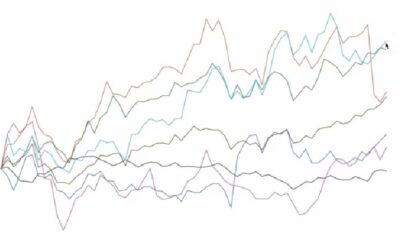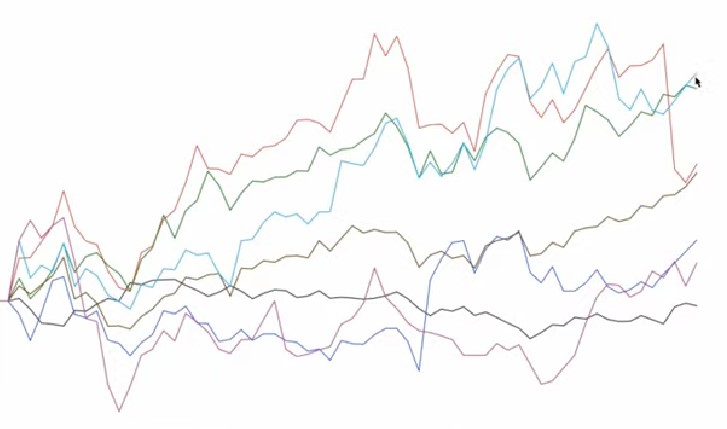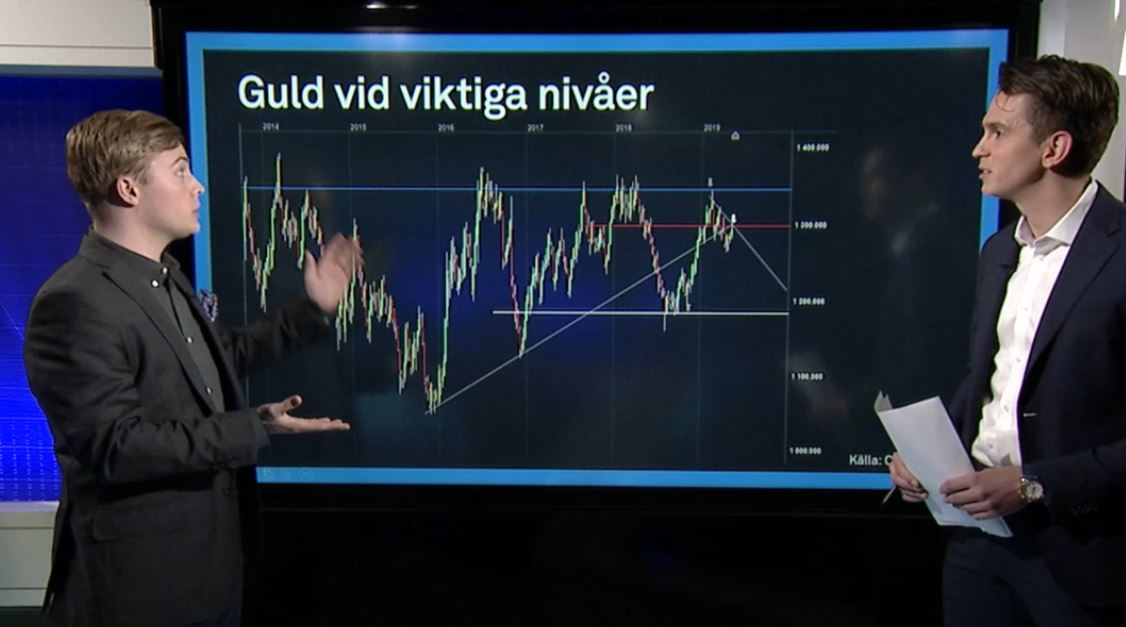Analys från DailyFX
A Clear Bear Flag in AUD/NZD That Probably Won’t Work
Talking Points:
- Apparent Bear Flag Pattern in AUD/NZD
- The Hidden Support Zone That Changes Everything
- How to Overcome Recent Countertrend Momentum
As the market appears to be finally transitioning out of a relatively difficult cycle from the past month of trading, patterns are also undergoing a period of readjustment. Often, during times like these, certain novel situations can arise, and today’s set-up in AUDNZD comes as a classic example of that.
The weekly chart below is sporting a clear downtrend, but one that has recently broken a steep declining line of resistance. This is strong evidence that the longer-term momentum is slowing down. According to textbook analysis, price should then rally or consolidate sideways to meet the next declining line of resistance, which stands more than 1,000 pips away.
Guest Commentary: Weakening Downtrend in AUD/NZD
Although the idea of a 1000-pip move is a distinctly juicy proposition, it is best to simply focus on smaller trades. Should price indeed rise that far, traders will be able to ride that move as a matter of course.
The bullish bias is somewhat contradicted by the below daily chart, however, which shows a brief recent uptrend has been broken and a lower high formed within the last few days of trading.
Guest Commentary: Crucial Hidden Support Line for AUD/NZD
Classical chart pattern analysis would classify the above pattern as a bearish flag, and a break of this pattern (which has occurred) would be a bearish signal. And normally, this would be true. However, the daily chart also reveals a hidden horizontal line of support (at 1.0748) that could potentially wreck this pattern.
As a result of the hidden support line, price has to conclusively break this level to re-create firm bearishness. Thus, there is a distinct opportunity for nimble longs at this juncture.
The four-hour chart below offers lots of confluence support, all coinciding within the shaded blue box. There are horizontal support levels, the hidden support line from the daily chart, and the declining daily trend line all contained in this area.
In combination, these provide a support zone of 1.0744-1.0771. This zone is 27 pips deep, which is a very small risk zone for a trade that has literally 1,000 pips or more to move under the most optimistic scenario.
Guest Commentary: Confluence Support on 4-Hour Chart of AUD/NZD
The challenge, of course, is the downward momentum currently being exhibited by price.
Classical Elliott wave analysts will likely have some bones to pick about the wave count marked on the below hourly chart. However, it is quite likely that price, having already made a momentum move, may pull back a little before making a final charge lower into the shaded blue support zone.
Guest Commentary: Elliott Wave Pattern in Play for AUD/NZD
The trade would actually be less tempting if price simply charged straight in. Nonetheless, it is possible to take a long from this zone using pin bars, bullish reversal divergence, and/or bullish engulfing patterns on this hourly time frame.
As always, two or three attempts may be required, and traders can consider using reduced risk in order to account for the threatening momentum, particularly if wave 3 does charge straight into the support zone without a pullback.
By Kaye Lee, private fund trader and head trader consultant, StraightTalkTrading.com
Analys från DailyFX
EURUSD Weekly Technical Analysis: New Month, More Weakness
What’s inside:
- EURUSD broke the ‘neckline’ of a bearish ‘head-and-shoulders’ pattern, April trend-line
- Resistance in vicinity of 11825/80 likely to keep a lid on further strength
- Targeting the low to mid-11600s with more selling
Confidence is essential to successful trading, see this new guide – ’Building Confidence in Trading’.
Coming into last week we pointed out the likelihood of finally seeing a resolution of the range EURUSD had been stuck in for the past few weeks, and one of the outcomes we made note of as a possibility was for the triggering of a ’head-and-shoulders’ pattern. Indeed, we saw a break of the ’neckline’ along with a drop below the April trend-line. This led to decent selling before a minor bounce took shape during the latter part of last week.
Looking ahead to next week the euro is set up for further losses as the path of least resistance has turned lower. Looking to a capper on any further strength there is resistance in the 11825-11880 area (old support becomes new resistance). As long as the euro stays below this area a downward bias will remain firmly intact.
Looking lower towards support eyes will be on the August low at 11662 and the 2016 high of 11616, of which the latter just happens to align almost precisely with the measured move target of the ‘head-and-shoulders’ pattern (determined by subtracting the height of the pattern from the neckline).
Bottom line: Shorts look set to have the upperhand as a fresh month gets underway as long as the euro remains capped by resistance. On weakness, we’ll be watching how the euro responds to a drop into support levels.
For a longer-term outlook on EURUSD, check out the just released Q4 Forecast.
EURUSD: Daily
—Written by Paul Robinson, Market Analyst
You can receive Paul’s analysis directly via email bysigning up here.
You can follow Paul on Twitter at@PaulRobinonFX.
Analys från DailyFX
Euro Bias Mixed Heading into October, Q4’17

Why and how do we use IG Client Sentiment in trading? See our guide and real-time data.
EURUSD: Retail trader data shows 37.3% of traders are net-long with the ratio of traders short to long at 1.68 to 1. In fact, traders have remained net-short since Apr 18 when EURUSD traded near 1.07831; price has moved 9.6% higher since then. The number of traders net-long is 15.4% lower than yesterday and 16.4% higher from last week, while the number of traders net-short is 0.4% higher than yesterday and 10.5% lower from last week.
We typically take a contrarian view to crowd sentiment, and the fact traders are net-short suggests EURUSD prices may continue to rise. Positioning is more net-short than yesterday but less net-short from last week. The combination of current sentiment and recent changes gives us a further mixed EURUSD trading bias.
— Written by Christopher Vecchio, CFA, Senior Currency Strategist
To contact Christopher Vecchio, e-mail cvecchio@dailyfx.com
Follow him on Twitter at @CVecchioFX
To be added to Christopher’s e-mail distribution list, please fill out this form
Analys från DailyFX
British Pound Reversal Potential Persists Heading into New Quarter

Why and how do we use IG Client Sentiment in trading? See our guide and real-time data.
GBPUSD: Retail trader data shows 38.2% of traders are net-long with the ratio of traders short to long at 1.62 to 1. In fact, traders have remained net-short since Sep 05 when GBPUSD traded near 1.29615; price has moved 3.4% higher since then. The number of traders net-long is 0.1% higher than yesterday and 13.4% higher from last week, while the number of traders net-short is 10.6% lower than yesterday and 18.3% lower from last week.
We typically take a contrarian view to crowd sentiment, and the fact traders are net-short suggests GBPUSD prices may continue to rise. Yet traders are less net-short than yesterday and compared with last week. Recent changes in sentiment warn that the current GBPUSD price trend may soon reverse lower despite the fact traders remain net-short.
— Written by Christopher Vecchio, CFA, Senior Currency Strategist
To contact Christopher Vecchio, e-mail cvecchio@dailyfx.com
Follow him on Twitter at @CVecchioFX
To be added to Christopher’s e-mail distribution list, please fill out this form
-
Analys från DailyFX10 år ago
EUR/USD Flirts with Monthly Close Under 30 Year Trendline
-
Marknadsnyheter5 år ago
BrainCool AB (publ): erhåller bidrag (grant) om 0,9 MSEK från Vinnova för bolagets projekt inom behandling av covid-19 patienter med hög feber
-

 Marknadsnyheter3 år ago
Marknadsnyheter3 år agoUpptäck de bästa verktygen för att analysera Bitcoin!
-
Analys från DailyFX12 år ago
Japanese Yen Breakout or Fakeout? ZAR/JPY May Provide the Answer
-

 Marknadsnyheter2 år ago
Marknadsnyheter2 år agoDärför föredrar svenska spelare att spela via mobiltelefonen
-
Analys från DailyFX12 år ago
Price & Time: Key Levels to Watch in the Aftermath of NFP
-
Analys från DailyFX8 år ago
Gold Prices Falter at Resistance: Is the Bullish Run Finished?
-

 Nyheter7 år ago
Nyheter7 år agoTeknisk analys med Martin Hallström och Nils Brobacke














